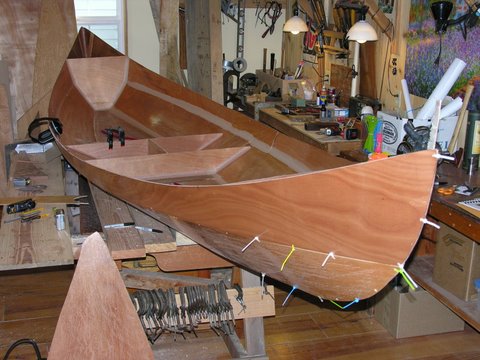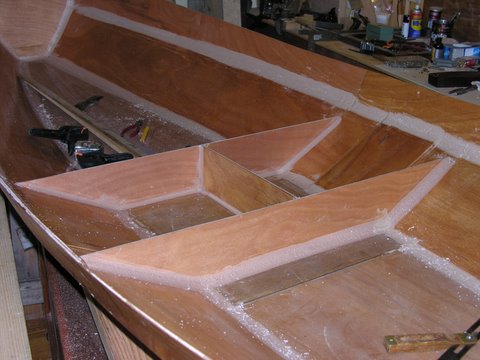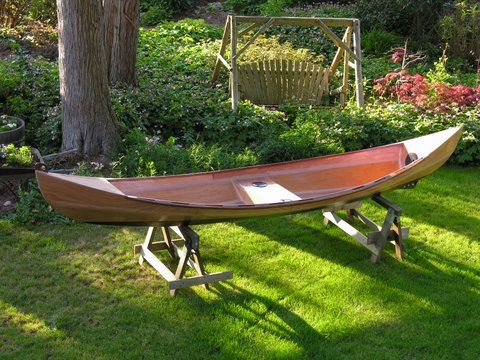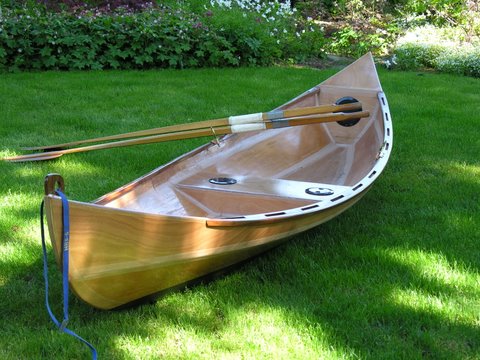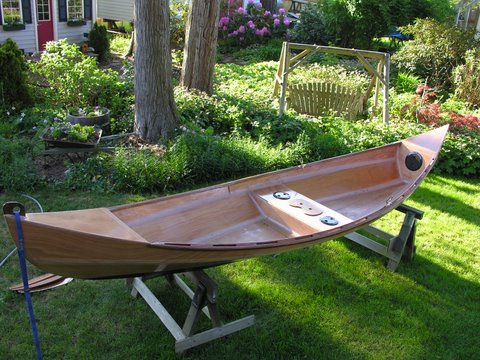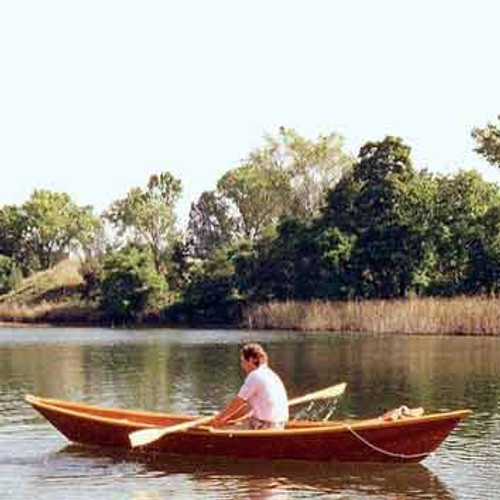Note: These plans consist of a booklet of 41 pages of text, drawings and photos on 8.5" x 11" pages. The printed version is black and white. The PDF file for instant download has color photographs. To save $5 and postage costs choose the download option by ordering HERE
drawn with inspiration from the classic lines of Scandinavian watercraft
This lightweight ply/epoxy Norwegian Gunning Dory was drawn with inspiration from the classic lines of Scandinavian watercraft. These types of work boats evolved for a variety of uses in the Norwegian fjords and along the 15,000 miles of dramatic coastline with weather to match.
The ply/epoxy hull is much simplified from traditional built plank-on-frame versions and the lightweight version can weigh less than 60 pounds which makes an easy cartopper. Instead of the traditional V bottom there is a flat panel on the hull bottom to simplify construction and provide extra stability. Directional stability for open water rowing can be enhanced by a shallow keel or in rougher water a short skeg works best.
The taped double chines in the hull provide fore and aft stringer support and in place of traditional ribs and frames there are fore and aft watertight compartments which provide additional hull support plus the safety of flotation spaces and dry storage for gear. Additional compartments are optional and may be added depending on how the boat is used and open water versions can even be built self-bailing by leaving a small volume footwell with a drain.
There are a number of optional interior layouts and room for 2 fixed seat rowing stations, or a single sliding seat. For a full-body workout the lightweight boat is fast enough to make exercise rowing with a sliding seat interesting. The 15 foot 9 inch overall length and the 45 inch beam provides close to ideal spacing for 7 to 8 foot oars.
If you're looking for an historically accurate replica all copper rivet fastened with steam bent ribs and hand hewn planks of Norwegian Spruce soaked in boiled linseed oil - this probably isn't what you're looking for, but if you want a lightweight, tough, low maintenance rowing boat with workboat character and good manners in open water this might work. Loaded down with gear for camp-cruising, or a passenger and gear, the boat becomes increasingly stable for general recreation, fishing, drifting small streams and exploring waterways. Maintenance is much reduced with epoxy sealed plywood and the slick, hard graphite covered bottom allows dragging the hull over parking lots, launch ramps and gravel beaches.
The 31 page building plans include photos, sketches, step-by-step directions and a discussion of many options to help the amateur builder customize the boat to suit usage. Plans will be available when the boat publishes in Outdoor Life magazine, scheduled for early in 2010.
Additional questions can be sent to: paul@butlerprojects.com
**********
Customer Comments and Pictures
.....ideal for fishing and exploring small streams here in Oregon and its light enough we can slide it down these steep banks almost anywhere and pull it out where its convenient. I did sheathe and graphite the bottom panel like the plans suggested and because its so light I drag it over trails with a tether. The 8 foot oars were too long for really small streams and I bought some cheap 5 footers that I use in brushy narrow backwaters. With just me in the boat I think it floats in a little over 3 inches of water so I can get right into the shallows. We car-top it into Newport.
Ron Gau
**********
She is complete. I stuck exactly to plans with the basic construction. She came out in perfect proportions. For breast hooks I used 200 year old teak, felled in India in 1932 and used on HMS Queen Mary decks and salvaged by me years ago when she first arrived in Long Beach. The oars are straight grain pine - design supplied by Chuck Leinweber at Duckworks. Thank you for all your help and advice.
Paul
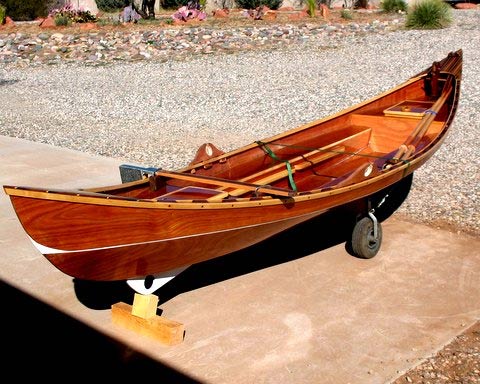
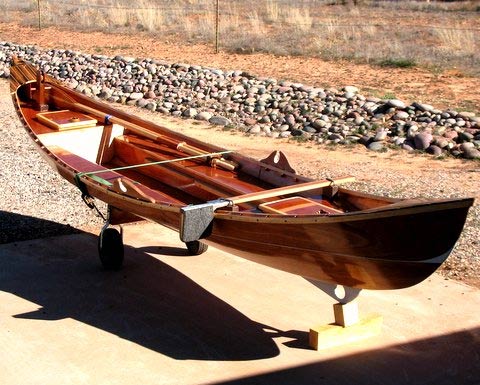
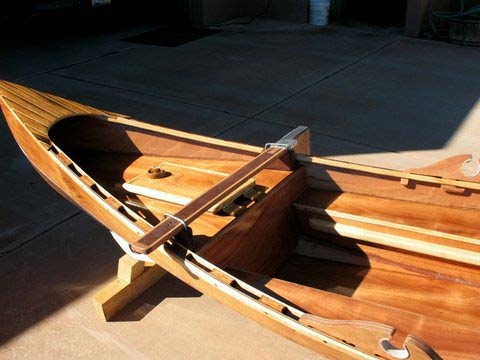
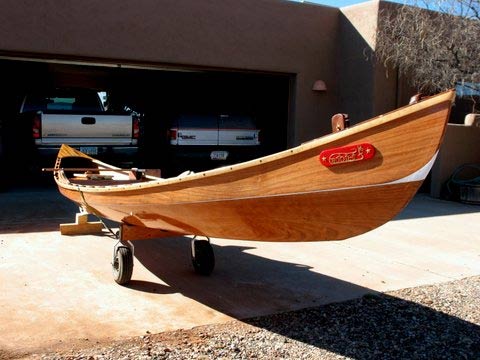
**********
Thanks Paul!
...my gun dory is heading to Thousand Island in upstate New York. My son lives 2 blocks from the St Lawrence seaway and this is the boating capital of New York. Your boat will fit right in with the Adirondack Canoes and is my graduation present to my son, who now holds a Masters in Applied Archeology. And he loves Nordic mythology.
Without your help and patience this would not have happened. Seat & gunwales are ash. Copper guard on front is from a 2' pipe.
Steve, Slippery Rock, PA




**********
Paul.... Here are some more pics. I am not a very good photographer. Better background scenery will have to wait as its winter here in Idaho, and I'm still in the process of finishing the boat including building riser blocks for the oarlocks. Building the boat was a good experience and the plans were easy to follow although, with my carpentry skills being what they are, there was still a learning curve involved.The entire boat is 6 mil Aquatek. I left the sides of the boat at 6 mil instead of 4 mil, and I may end up covering the hull in glass. The rings on the bow and stern are my anchor and tie down points when the boat is on the top of my truck and its still light enough that I can handle it by myself. The Holidays and Idaho's winter delayed the launch but as soon as I find a lake that is not covered in ice I'll send more photos and let you know how it acts in the water.
Cameron


**********
JESSES BOATHere's an alternate interior layout for the NGD. Slightly more complex but better suited to rowing with 1 or 2 people, and camp cruising. The port and starboard parallel compartments provide considerable additional storage and flotation capability, and also simplify the process of adjusting the seating for varying loads. This boat is fast enough to make open water sliding seat rowing enjoyable, and by installing a track and roller system a sliding seat could easily be achieved, or a drop-in sliding seat can be installed between the compartments. Or a permanent fixed seat can also be attached across the compartments. Details and options for this interior layout are also included in the building plans.
**********



